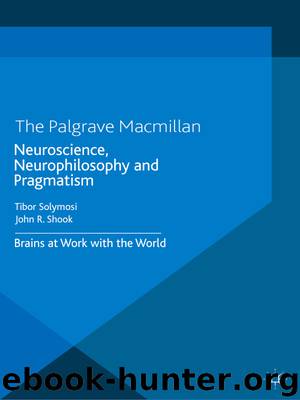Neuroscience, Neurophilosophy and Pragmatism by Tibor Solymosi & John R. Shook

Author:Tibor Solymosi & John R. Shook
Language: eng
Format: epub
ISBN: 9781137376084
Publisher: Palgrave Macmillan
Published: 2014-06-12T16:00:00+00:00
Part III
Creativity, Education, and Application
8
Finding Unapparent Connections: How Our Hominin Ancestors Evolved Creativity by Solving Practical Problems
Robert Arp
Introduction
John Dewey and other noted pragmatists of his time utilized evolutionary insights to inform the ‘lived experience’ of human psychology, which included responding to one’s environment in novel ways. Dewey speaks of ‘finding unapparent connections’ to be an important human mental ability that is at times utilized for solving problems. In this chapter, I argue that the lived, practical experiences of our hominin ancestors occasioned the emergence of an ability to solve problems creatively, in a way unique among primate species. Specifically, in this chapter I first present the ideas and arguments put forward by evolutionary psychologists that our hominin ancestors evolved certain capacities to solve nonroutine, vision-related problems creatively. I then argue that scenario visualization – namely, a mental activity whereby visual images are selected, integrated, and then transformed and projected into visual scenarios for the purposes of solving problems in the environments in which one inhabits – emerged in our hominin past and accounts for certain kinds of vision-related creativity. The kinds of problems with which our hominin ancestors were confronted most likely were of the practical, spatial-relation and depth-relation types, so the capacity to scenario visualize would have been useful for their survival. Thus, scenario visualization has been and still continues to be relevant for vision-related forms of creative problem solving.
Prepared to act
There is an oft-quoted passage from Charles Peirce where he claims that Alexander Bain (1818–1903) is probably the ‘grandfather of pragmatism’ because of Bain’s definition of belief as ‘that upon which a man is prepared to act.’1 Our early hominin ancestors of around 2 million years ago (mya) certainly were pragmatists in the colloquial sense of the word, since the beliefs they formed almost always had to do with assessing situations and solving problems in their environments in practical, matter-of-fact ways. Simple beliefs associated with the perception that, ‘He’s trying to take my food,’ ‘We need shelter from the cold,’ ‘That wooly mammoth is getting away,’ or ‘That saber-toothed cat is coming at me’ are ones upon which many an early hominin were prepared to act, with the time between preparation and action being quite short in some cases. Much of the time, not being prepared to act meant death of individuals and/or even entire species.
But had they the opportunity to speculate on the very nature of their beliefs – when they weren’t feasting, fighting, fleeing, foraging, or engaged in other basic life-preserving activities – our early hominin ancestors likely would have subscribed to classical and other contemporary forms of philosophical pragmatism provided, of course, Peirce is correct about the interconnection between pragmatism and Bain’s definition. Peirce, along with William James, George Herbert Mead, John Dewey, and other noted classical pragmatists around the turn of the 20th century actually utilized evolutionary insights to inform the development of human psychology in terms of belief formation and preparedness to act. In this chapter, utilizing evidence from biology, neuroscience, and evolutionary
Download
This site does not store any files on its server. We only index and link to content provided by other sites. Please contact the content providers to delete copyright contents if any and email us, we'll remove relevant links or contents immediately.
| Anthropology | Archaeology |
| Philosophy | Politics & Government |
| Social Sciences | Sociology |
| Women's Studies |
The remains of the day by Kazuo Ishiguro(8733)
Tools of Titans by Timothy Ferriss(8147)
Giovanni's Room by James Baldwin(7110)
The Black Swan by Nassim Nicholas Taleb(6941)
Inner Engineering: A Yogi's Guide to Joy by Sadhguru(6628)
The Way of Zen by Alan W. Watts(6447)
Asking the Right Questions: A Guide to Critical Thinking by M. Neil Browne & Stuart M. Keeley(5572)
The Power of Now: A Guide to Spiritual Enlightenment by Eckhart Tolle(5527)
The Six Wives Of Henry VIII (WOMEN IN HISTORY) by Fraser Antonia(5347)
Astrophysics for People in a Hurry by Neil DeGrasse Tyson(5090)
Housekeeping by Marilynne Robinson(4250)
12 Rules for Life by Jordan B. Peterson(4217)
The Ethical Slut by Janet W. Hardy(4145)
Double Down (Diary of a Wimpy Kid Book 11) by Jeff Kinney(4133)
Skin in the Game by Nassim Nicholas Taleb(4121)
Ikigai by Héctor García & Francesc Miralles(4040)
The Art of Happiness by The Dalai Lama(4007)
Skin in the Game: Hidden Asymmetries in Daily Life by Nassim Nicholas Taleb(3866)
Walking by Henry David Thoreau(3854)
